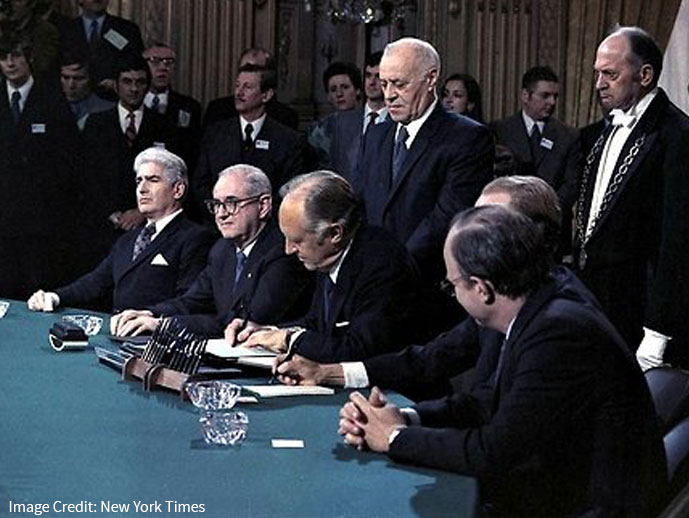On January 23, 1973, US President Richard Nixon went on air to announce a peace accord with Vietnam ending about two decades of America’s longest military engagement in the Asian countries of Vietnam, Cambodia, and Laos. The United States, South Vietnam, North Vietnam, and Việt Nam Cộng-sản formally signed “An Agreement Ending the War and Restoring Peace in Vietnam”, also known as the Paris Peace Accords thus acquiescing to the growing demand to end action in Vietnam. The peace agreement was effective from January 27, 1973. The US involvement in the region came with a staunch opposition to the spread of communism and rise of the Soviet Republic at the close of World War II. Vietnam threatened to emerge as the next communist foothold leading to an American opposition to the Vietnamese struggle for independence. Initially, the backing had been restricted to a financial support extended to France, the colonial power controlling Vietnam, in the first Indochina War from 1946. Indochina eventually split into 3 countries – Laos, Cambodia, and Vietnam. North and South Vietnam had initially agreed to hold an election and merge to form a cohesive nation but the anti-communist South backed out in 1956. The move was supported by the US. By 1960, the emergence of the National Liberation Front or the Viet Cong was perceived as a major threat to the South Vietnam government. In 1964, the US Congress passed the Gulf of Tokin Resolution authorizing President Lyndon Johnson to fight the war in Vietnam. In 1969, President Richard Nixon proposed “Vietnamization” – a policy that made South Vietnam in charge of the war against the North while the US continued to provide essential aid and military support. The United States and Hanoi embarked on what would turn out to be five year-long peace talks in 1968. Paris was chosen as the venue. By 1972 it also became clear that the South Vietnam was not capable of a full-fledged war without immense support from the US. By the mid-1960s, there were over 500,000 American troops deployed in Vietnam. Back home in America, protests against participation in the Vietnam War started to escalate to the next level with increasing numbers of celebrities becoming vocal. Americans started to question the ethics of the US war effort and the long drawn out war had succeeded in demoralizing the families of military personnel. The press started to take up the issue and demonstrations and peace marches had become a common scene. When the American public took to civil disobedience, it became clear that it was time to end the war and declare peace. By October 1972, it seemed likely that tentative cease-fire would soon be reached and President Nixon halted all bombing to the north of the twentieth parallel dividing North and South Vietnam. National security advisor Henry Kissinger declared that “peace was at hand.” December 1972, however brought back war with a jolt. In 12 days of heavy bombing around Christmas that year American fighter planes flew 2,000 sorties and dropped 35,000 tons of bombs on North Vietnam destroying much of the region’s oil resources and affecting life and property on a major scale. Peace talks then resumed on January 8, 1973, leading up to the peace accord of January 27, 1973. South Vietnam’s persistent refusal to recognize the Việt Nam Cộng-sản – the Viet Cong’s Provisional Revolutionary Government also led to much delay in reaching a peace agreement. By early 1973, it was agreed that the Paris Peace Accord would be signed on different levels. Any reference to the Viet Cong’s provisional government would be restricted to the peace agreement signed by North Vietnam and the United States while South Vietnam would sign a different version of the accord which excluded all reference to the provisionary government. The immediate consequence was an immediate cease-fire across all of Vietnam. The United States also agreed to withdraw all its troops and advisors (about 23,700 at the time) deployed in the Asian nation and to take down all its bases in the next two months. North Vietnam, in turn, agreed to release all American prisoners of war. The countries also agreed to withdraw the troops deployed in Cambodia and in Laos. It was agreed that force would not be used to reunify the country and that President Nguyen Van Thieu of South Vietnam would continue in his office till the elections. The divide between North and South Vietnam was maintained at the 17th Parallel which continued until the eventual fall of Saigon in April 1975 and the ultimate reunification of Vietnam. The peace agreement was supervised by an international control commission comprising 1,160 inspectors. The inspection commission was made up of representatives from Canada, Hungary, and Poland. You may also like : January 23 2003 – NASA Loses Contact With Pioneer 10
January 23 1973 – US President Richard Nixon announces a peace accord with Vietnam
On January 23, 1973, US President Richard Nixon went on air to announce a peace accord with Vietnam ending about two decades of America’s longest military engagement in the Asian…
477
previous post
